Canada’s Toronto is a massive city that if, like us you are not really urban people, can feel overwhelming. However, in our two days visiting the city on our 2 month Maritime road-trip, we creamed off Toronto’s best bits, getting a great cultural feel of this Ontario capital city.
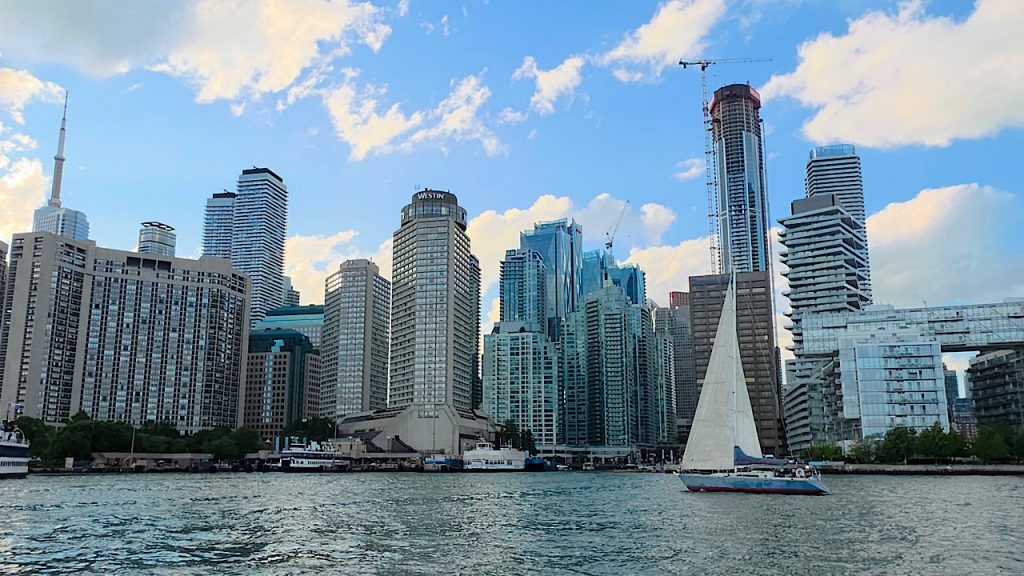
Cities are not everyone’s cup of tea, although for a rounded travel experience, we absolutely believe that interspersing a bit of urban into our love for nature and countryside is important. So when we planned our trip to Canada’s Maritime eastern-board, flying into Toronto, it made sense that we took a couple of days to explore this iconic cityscape. We stayed at the Westin Harbour Castle Hotel which is down on the Harbourfront region. It is ideal for accessing the key areas of the city with plenty of walking and the odd land and water taxi and subway thrown in for good measure.
Toronto is the fourth largest city in North America and the largest populated city in Canada, offering the traveller plenty of skyscraper vistas, parks and a lakeside perspective that eases the eye to the urban landscape. So here’s an itinerary guide that gives you a robust 2-3 day plan to get to know this magnetic city.
Day 1 – Toronto’s islands and Harbourfront
Arriving on a delayed flight from London Heathrow, we lost a day’s exploration, so we had to pack it all in, in a pretty short space of time. An extra day would certainly have given us a bit more of a relaxed feel to our city tour, although it was still doable.
After arriving into the hotel at lunchtime, we gave our body clocks a little time to adjust to the five hours time difference from the UK. Not wanting to miss the opportunity to both nourish our weary souls and also to see something of the city, we decided to go for a water taxi that was just outside our hotel, taking us over to the Toronto Islands. For a standard rate water taxi of $13 per person one way, you get access to the archipelago that form a lagoon in front of the city. Each island is linked with bridges allowing you to wander or hire bicycles to explore this lovely green space. It is such a treat to have so much open space on the fringes of a city landscape. And something must be said about that panorama too. From the islands, the views to the skyscrapers are absolutely incredible and for this alone, it is well worth the taxi across, which in itself is a wonderful Toronto experience that you cannot miss.
We visited at the beginning of September, which is officially the end of the high season, when the schools are back. So things do tend to start slowing down on the islands. However the taxis run regularly, weather dependent so getting there is easy and there is very little waiting time.
If you prefer to eat at the popular Harbourfront before or after going over the islands, there are plenty of restaurants that you can enjoy along the promenade, watching the larger tourist boats filling up and doing their sunset tours of the lagoon. Certainly Toronto by night is a beautiful way to experience the city.
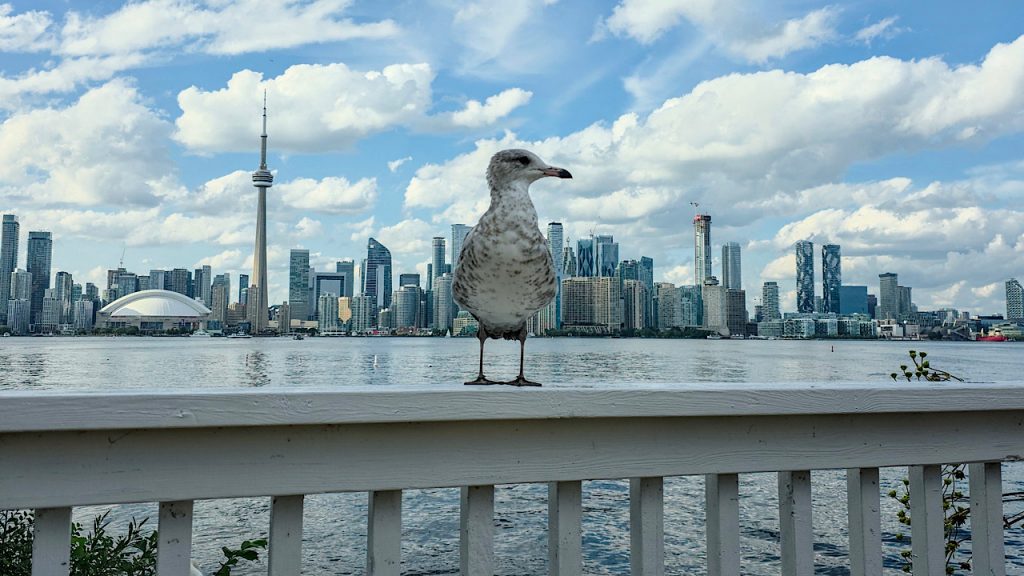
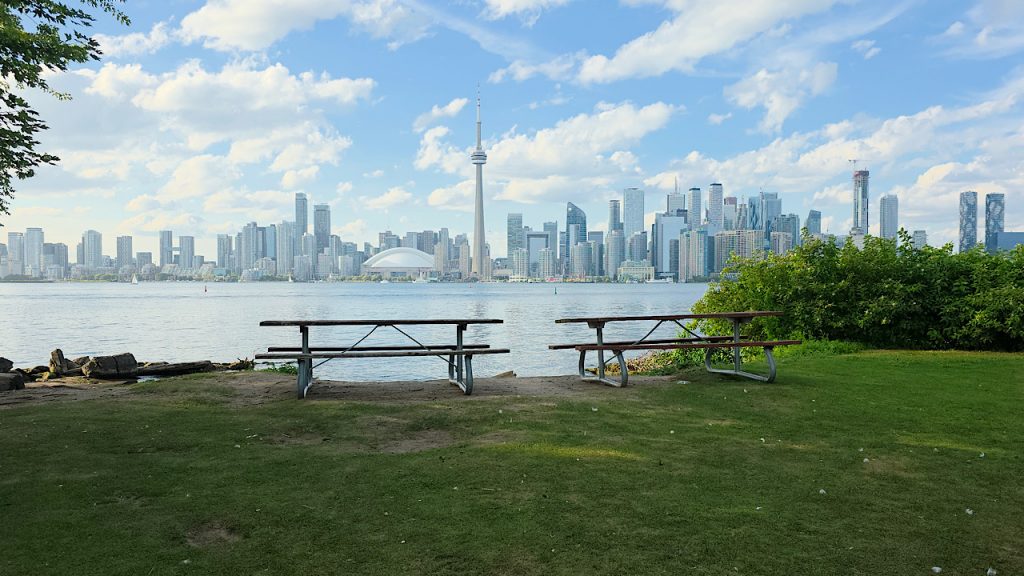
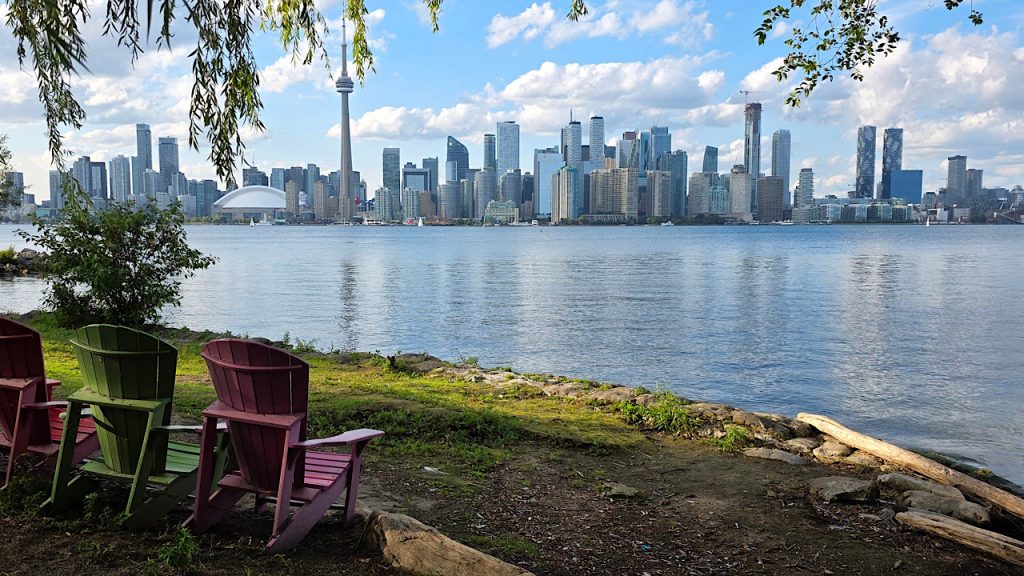
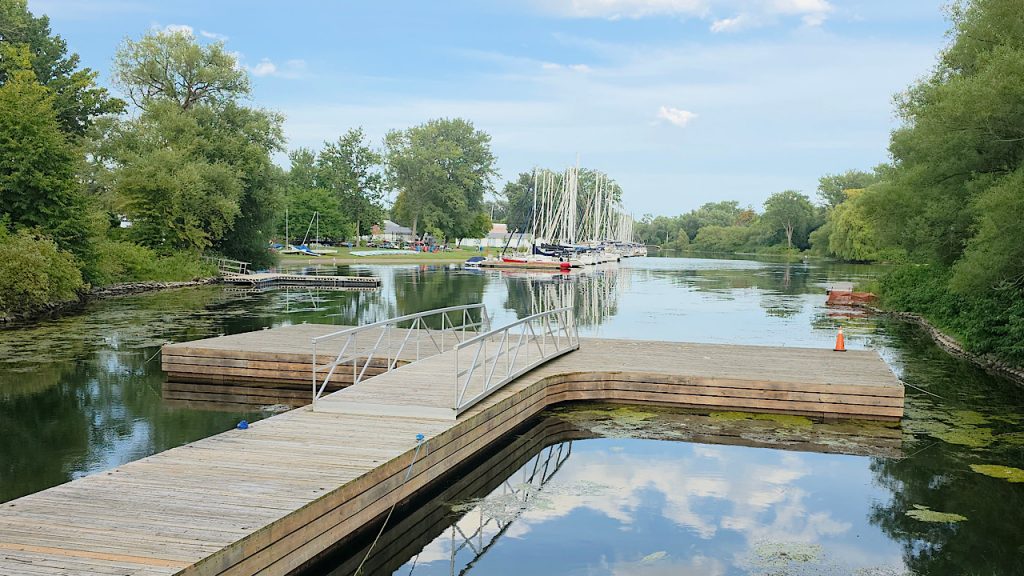
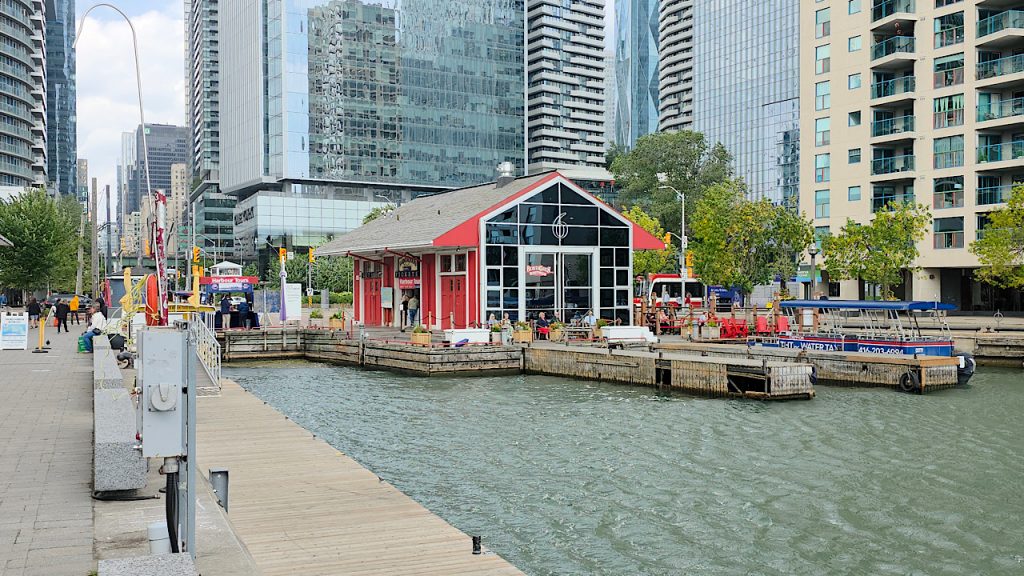
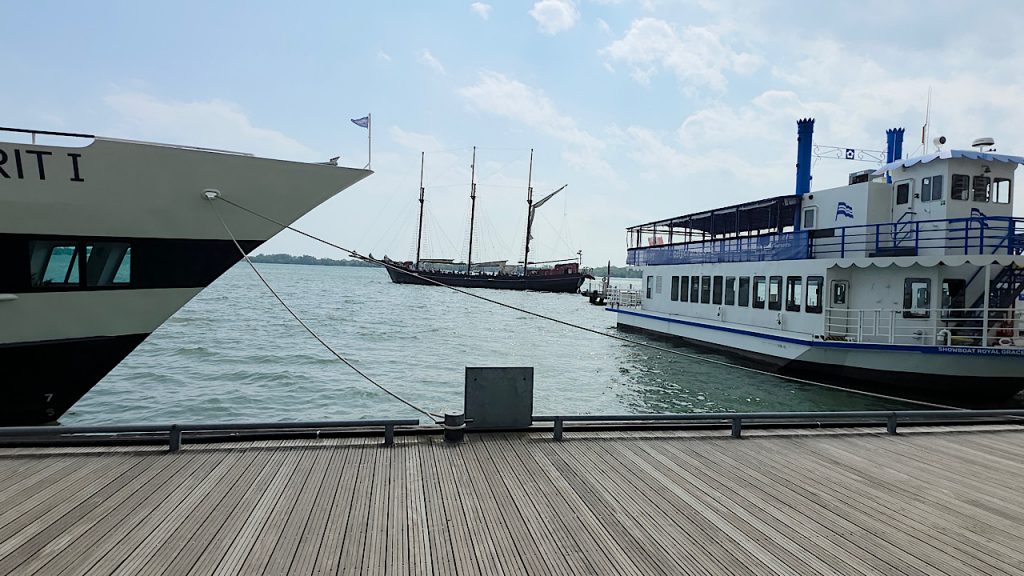
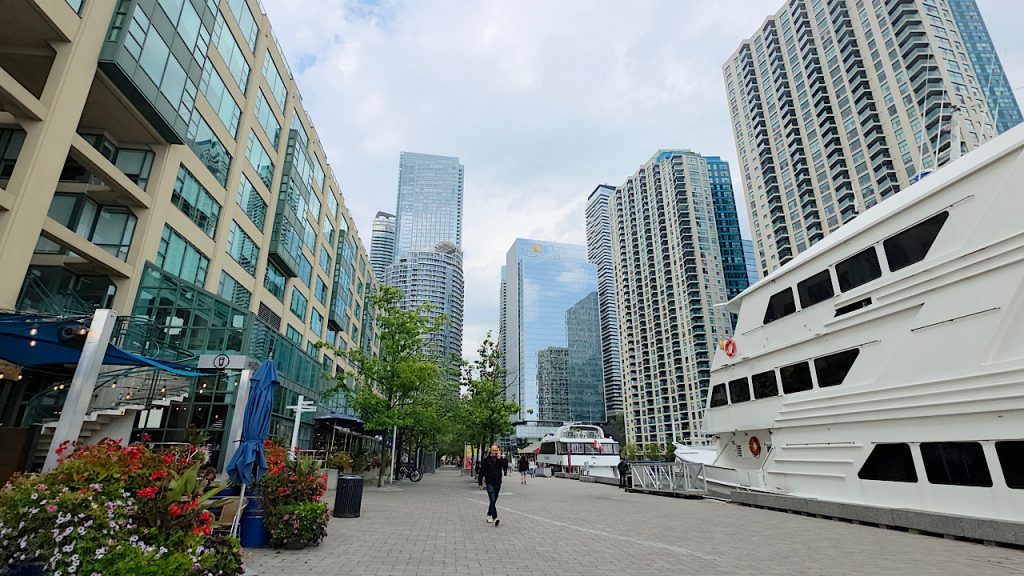
2. Day 2 – Daytime adventures around Toronto
We chose not to include breakfast in our hotel package, and instead to find our own meal that would be a cheaper affair and less intrusive than a crowded hotel buffet. So heading out at 10, we took a walk amongst the skyscraper giants, up on the longest street in the city. Yonge Street is worthy of note, as it was once classed as the ‘Longest Street in the World’. However that accolade has now been muted and it must suffer just the title of the city’s longest road, spanning 53km. Just to say that you have trodden upon its record breaking pavement is surely enough.
Our choice of cafe was Landwer Front on Yonge Street, which coincidently was right on the path of our second landmark. Berczy Park and the Flatiron Building. Both are quirky spots that just need those Social Media photographs. The Park is named after German architect William Berczy who is often thought to be the co-founder of modern day Toronto. Since 1980 this old parking lot has been revitalised with many sculptures, the most unique of which is the fountain adorned with cats and dogs.


A sight not to be missed the other side of the fountain is the Gooderham ‘Flatiron’ Building. Whilst the building itself wasn’t open when we visited, the mural on the outside is vision enough. The red brick triangular building was designed for George Gooderham who was the owner of Toronto’s largest distillery in 1892. It is one of Toronto’s most iconic old buildings and well worth the diversion.
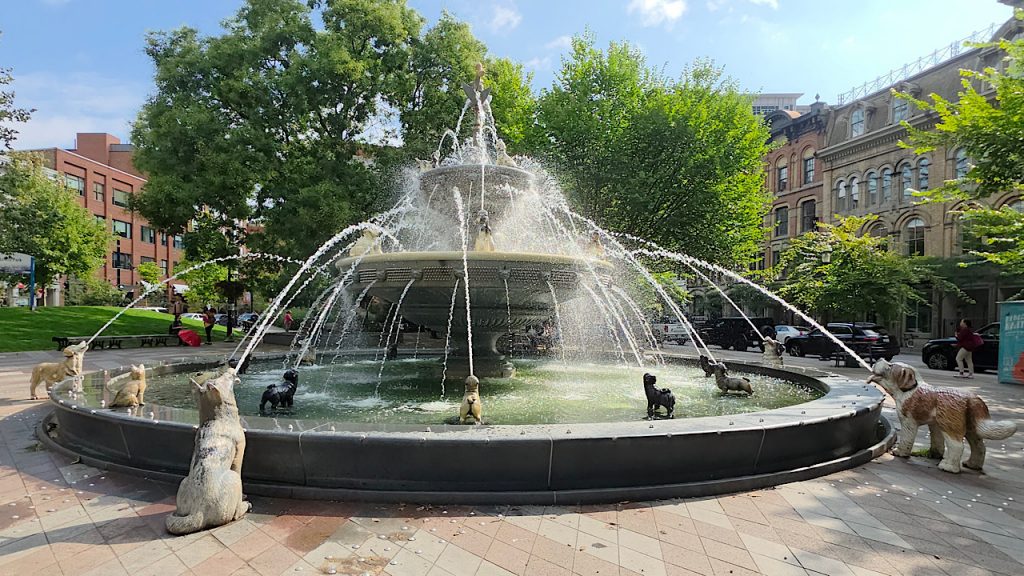
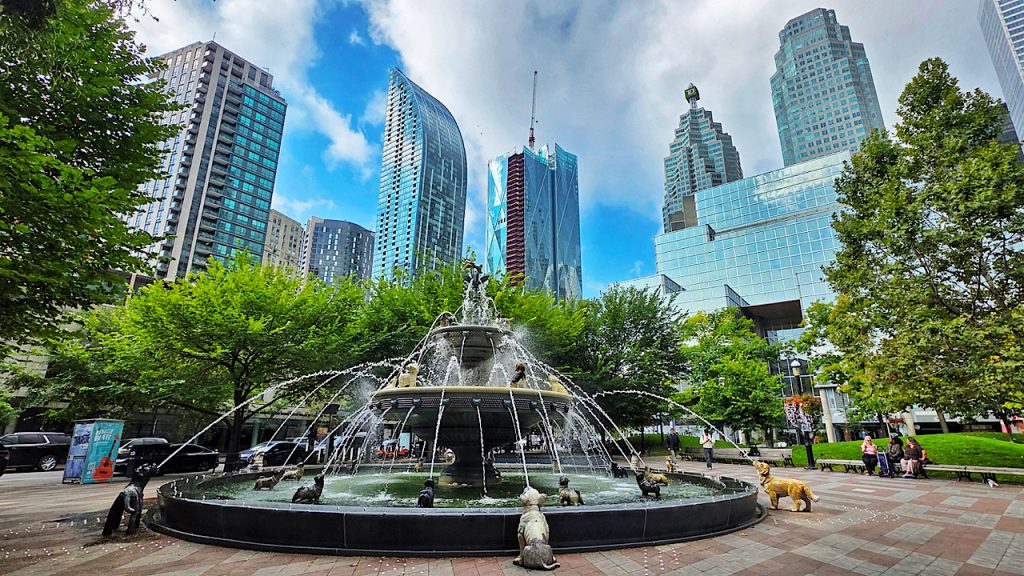
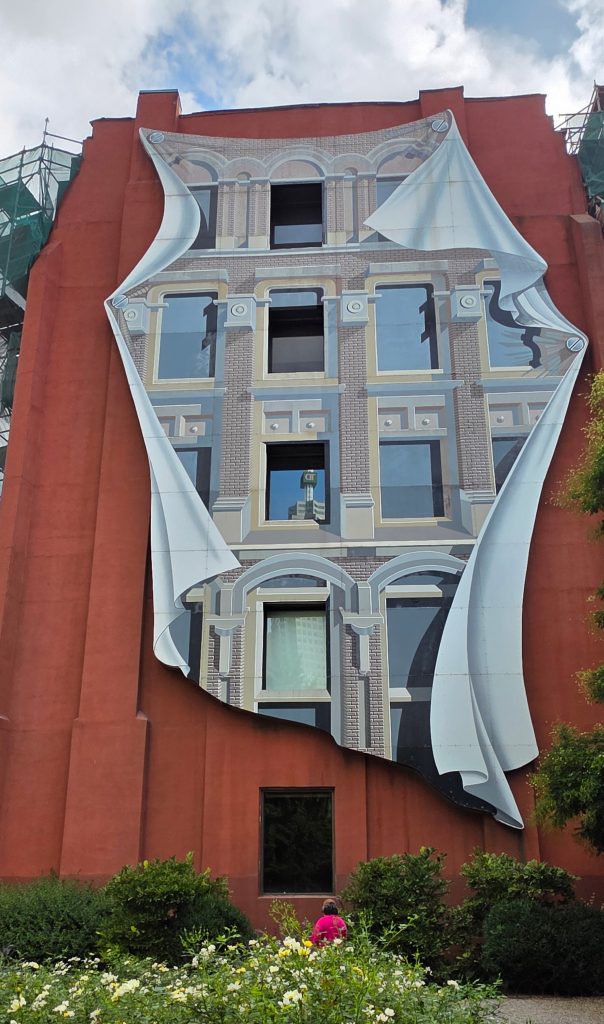
Keeping your line, past the Flatiron Building you will reach the next stopping point. A landmark that is perhaps not on the traditional tourist path. The St Lawrence Market. This is no normal market. This bears many old traditions of passionate artisans, many of whom have their art passed through generations from the last 200 years. Today, that passion lives on in the merchants who run their artisanal stalls on two floors of this magnificent building. Authentic tastes of Canada and Toronto will be found beneath this roof and if you want to experience real Toronto beyond the skyscraper giants, then the market is the place to come. Just bear in mind that Monday the market is closed. Please check the website for opening hours.




Our next station stop is about a 30 minute walk through Toronto’s old town sector to reach the Distillery District. Whilst on the face of it, this is a swanky area of the city with boutique shops and restaurants, there is history behind the commercialism. And this is the reason you must come here. Imagine a time when the transport was a horse-drawn carriage, windmill powered mills and a shipyard full of ships waiting for their cargo. A Victorian age where the industrial architecture was purposeful and practical, so unlike the characterful use of the buildings today.
Not only is the Distillery District a trendy ‘village’, it also has an accolade of National Historic Site. The village is a great example of Victorian life and design. Founded in 1832, Gooderham and Worts began as a windmill and soon became the largest distillery in the world. The complex today pays homage to the life of the mid 19th century and the heritage that belongs to that industrial era. So whether you want a tour of the first Craft Beer brewery in Toronto, to visit the building museums or grab lunch in one of the many outside establishments, then this is the place to come. We visited during a week day so understandably there was little atmosphere. An evening or weekend would put a very different perspective on the place. We loved wandering and imagining how life was nearly two hundred years ago.
From here, depending on the time you have available, you could follow our route, which involved getting an Uber up to the Casa Loma. See the next section for more information. Alternatively, and definitely our preferred way of doing it, take a break for the afternoon and chill back down on the Harbourfront and leave the rest until day 3.
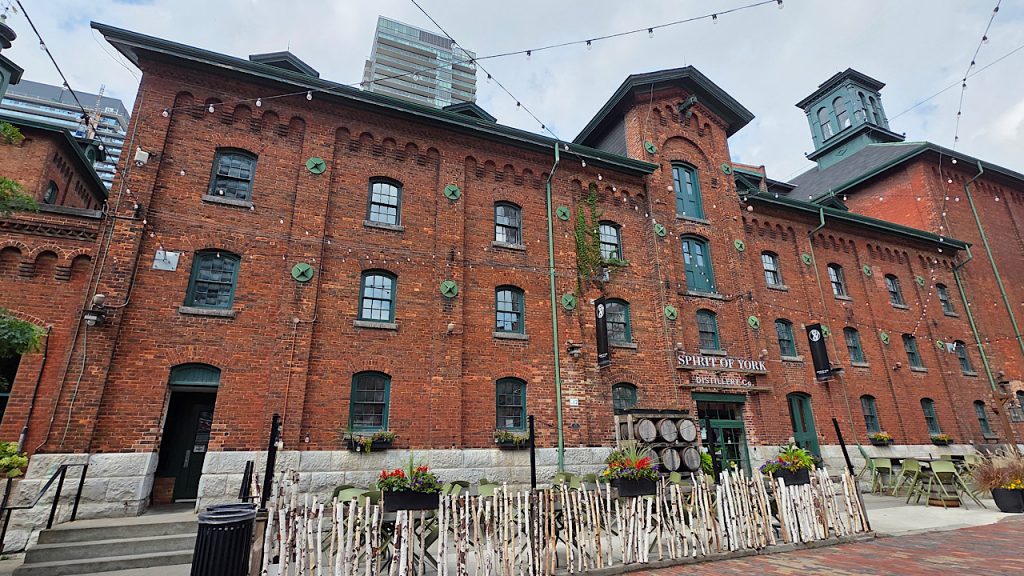
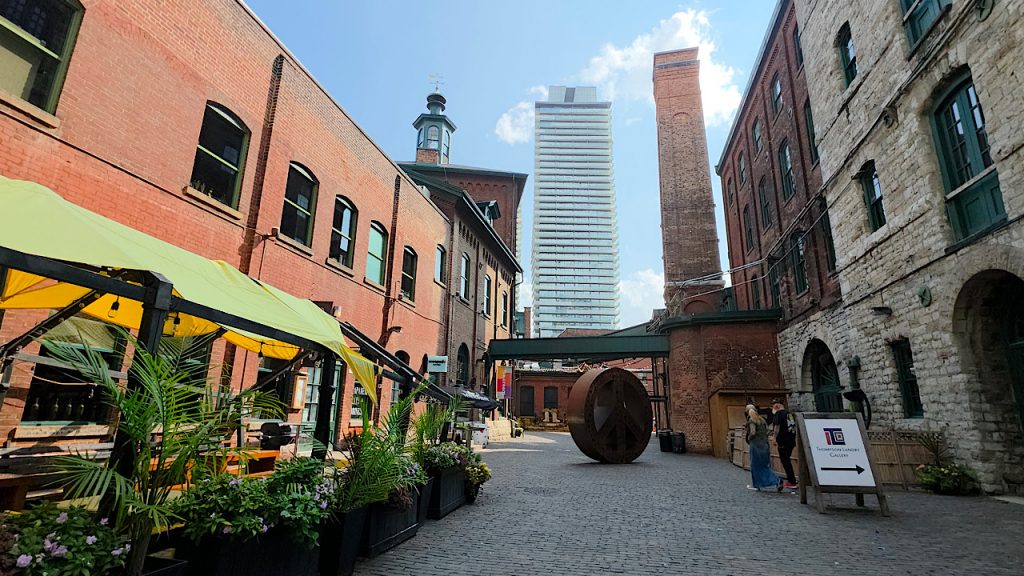
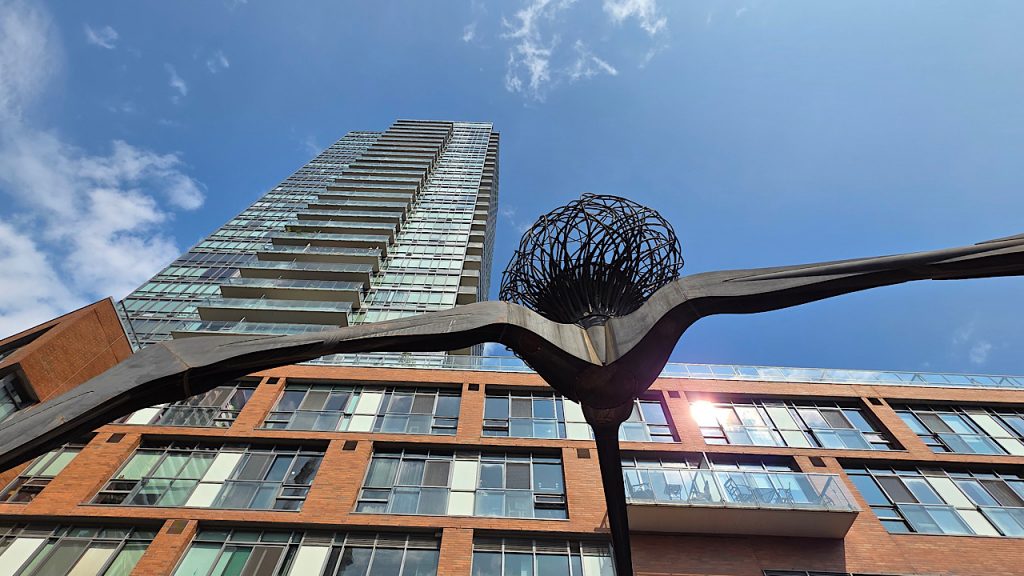
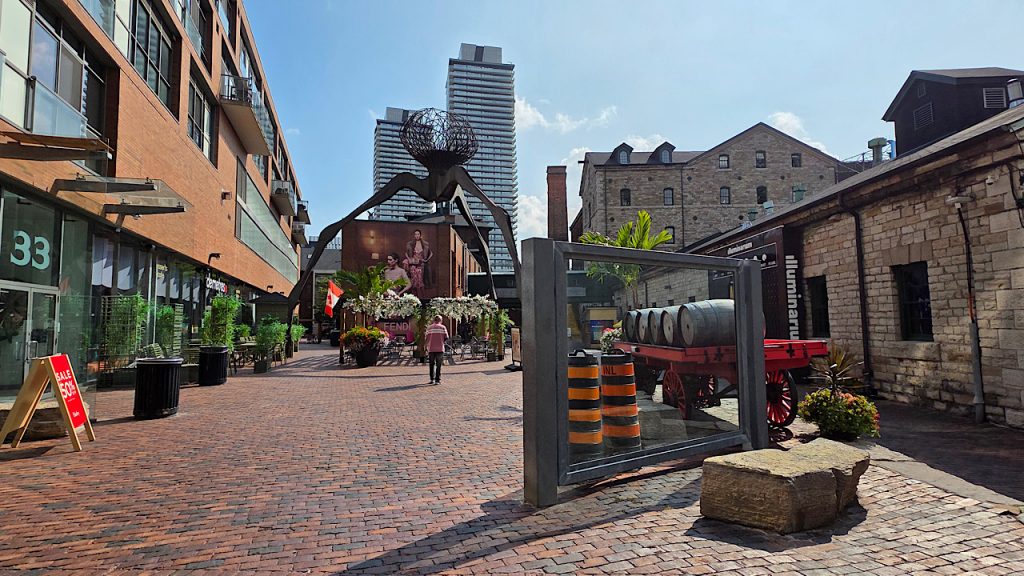
3. Day 3 Take a Bus and do a night at the CNN Tower
As we lost a day with our cancelled flight, we had to pack this Day 3 into our second day. Although it would not have been our preference, especially suffering from a bit of jet lag. So for the purposes of this guide, I want to allocate our afternoon day 2 and pop it into a separate, more nourishing day, where you can stagger your visit and take more time to watch the world go by.
You have a couple of options at this point. You could take the Hop on Hop Off bus that will take you around the main sights. For around £36 you can do a day tour, or for £27 you can do a night tour instead. It gives you 15 stops, most of which we have listed in Day 2 plus a few more.
Or you can choose our option, which was a £10 Uber from the Distillery District to Casa Loma. Alternatively you could just hop on the subway, which has a fabulous service taking you all around the city and its outer districts, the prices for which start at $3.30 for a one ride ticket.
Casa Loma and the Baldwin Steps are your next station stop. Reaching the bottom of the 19th century Staircase, it is worth taking the breath-busting 110 steps to the top, as you are not only walking along a geographical landmark, given it was an ancient lake shore line, it also has historical significance. The landowners of the time, the Baldwin family, created the steps to help the locals navigate the area more easily, given the steep terrain. There were plans for a 6 lane carriageway in the 1960s, although this was vitoed by the government to protect its heritage.
Once at the top of the steps, you can take a moment to wonder at the views across the city. The panorama is quite incredible. There are three buildings here worthy of note, and depending on your interests, budget and time, you can enter into the museums of all three of the estate buildings. The first is Casa Loma, a grand house that was built in 1914 by financier Sir Henry Pellatt. In 1883, on the back of Thomas Edison’s creation of steam powered electricity, he set up Toronto’s Electric Light company and his entrepreneurial prowess paid off. He bought the land for his dream house, which interestingly had already been named by the previous owner, the Spanish translation as ‘House on the Hill’.
The Casa Loma is a grand house, with its subterranean tunnels and lavish ground level rooms, and is completely out of character for the rest of the city. In fact it is the only castle of its size and style in North America. Influenced by his European travels, Pellatt adorned the interior with artwork from around the country and indeed the world. As a socialite, Pellatt hosted many parties here and even today, that sense of entertainment as a Function Venue, continues his theme. Sadly with increasing debt from his social diary, the taxes he had to pay and the breakdown of his electricity business, Pellatt was heading for bankruptcy. In 1924, he and his wife moved out and Casa Loma was turned into a hotel for a number of years. However there were many periods of it laying empty and purposeless. Today it is owned by the Toronto Government and is used for functions. You can also tour the castle and its grounds for a princely sum starting at $47 per person that’s approximately £24, which we thought was expensive. So we just admired it from the outside.
Whilst you are up there, it is worth exploring two other buildings just a short walking distance. The first is the Spadina House museum, which presents life in the 1920s-1930s and offers a Victorian style garden. General admission is free, although to visit the house you will need a guided tour. Check the website for details.
The second place you can check out whilst in this hill top area is the Casa Loma Stables. You can access this uniquely designed building via one of the castle’s underground tunnels. So your entry ticket includes a visit to the stables. If you decide not to enter the castle complex because of budget or time, you can see it from the outside quite adequately.
And with just a 10 minute walk back down the hill, you arrive at DuPont Subway, which is a cheap and quick way of getting back into the hub of the city for our next Check Point Charlie.
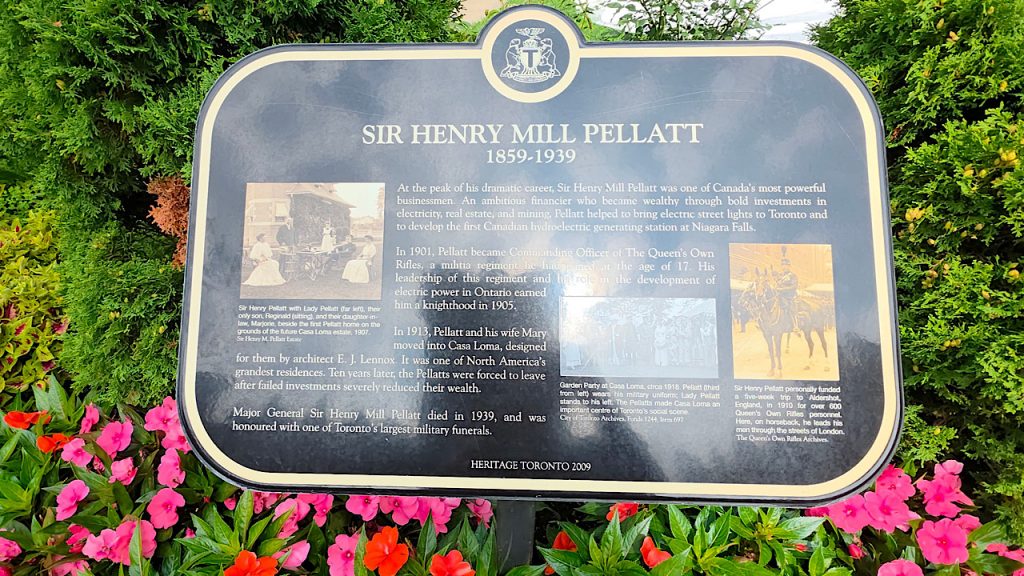
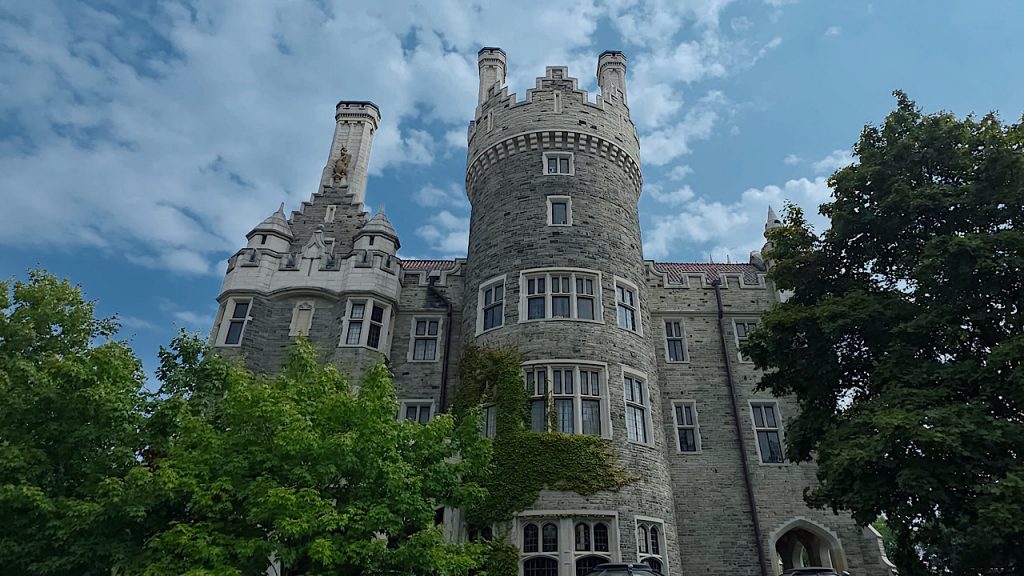
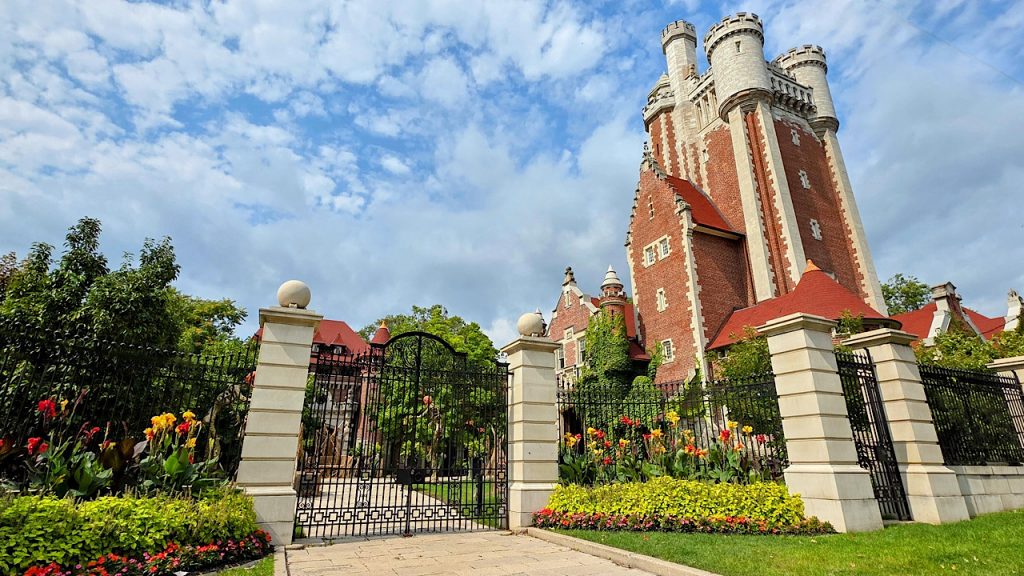
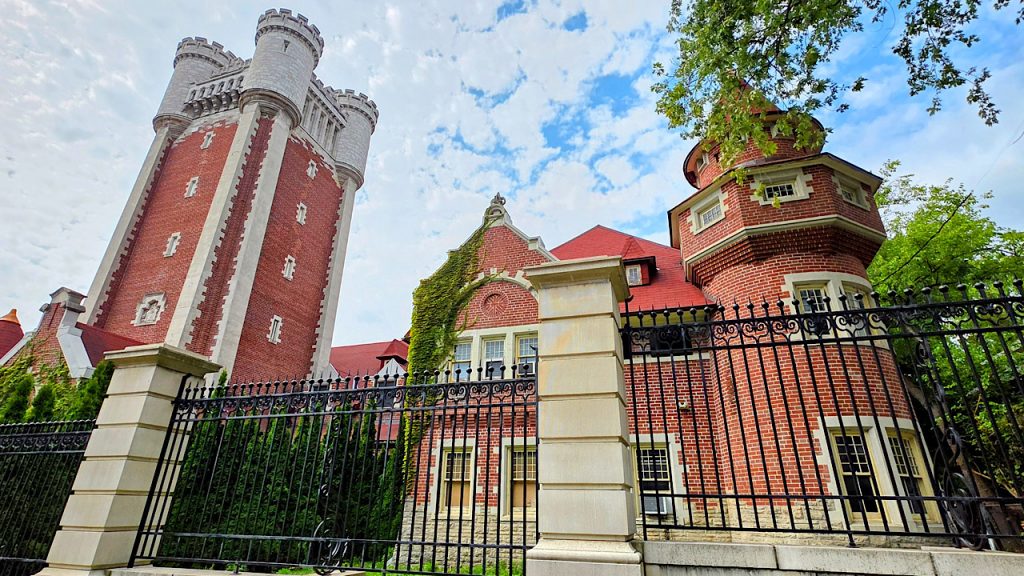
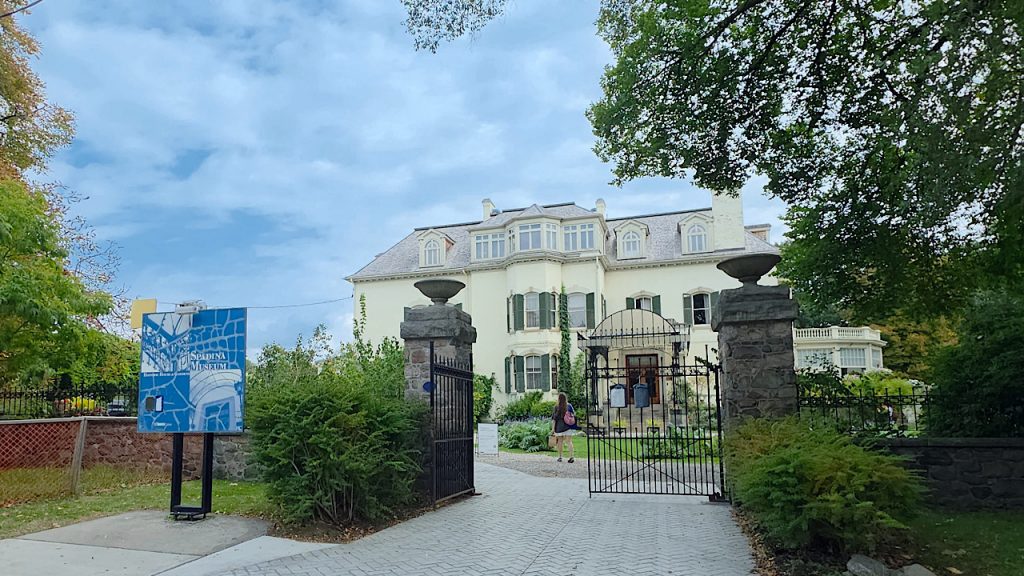
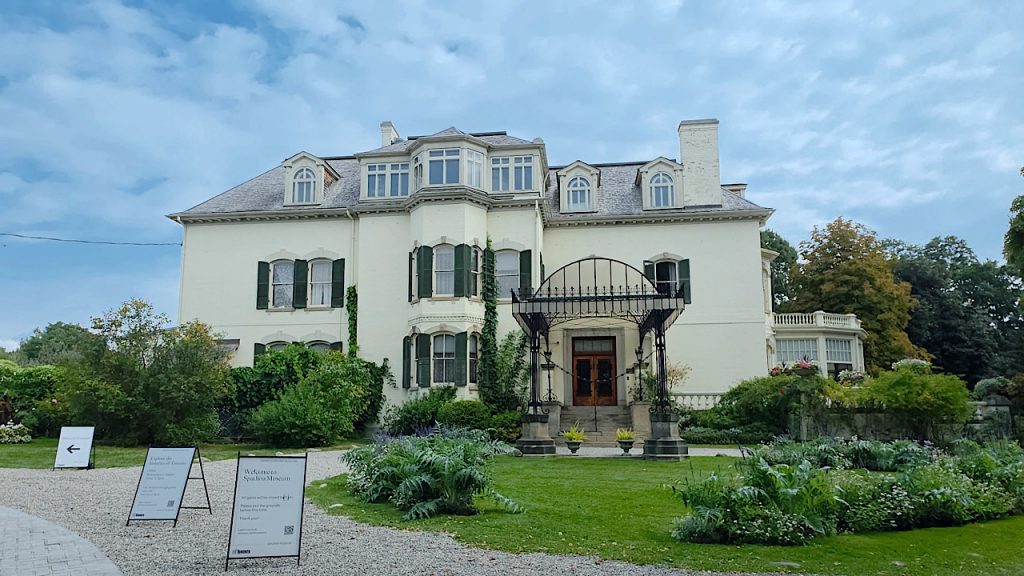

If you get off the subway at the Osgoode station, you arrive at the next Toronto National Historical landmark. The Osgoode Hall was built in 1883 and named after the Chief Justice of Upper Canada William Osgoode. Since its creation, it has been home to the Law Society of Ontario and has seen some landmark cases over the decades. You can enter with a guided tour and there is a restaurant that has good reviews. Or you can do as we did, with our weary feet and just nip into the gardens and marvel at the Neoclassical architecture and then head just behind the Hall to the Nathan Phillips Square.
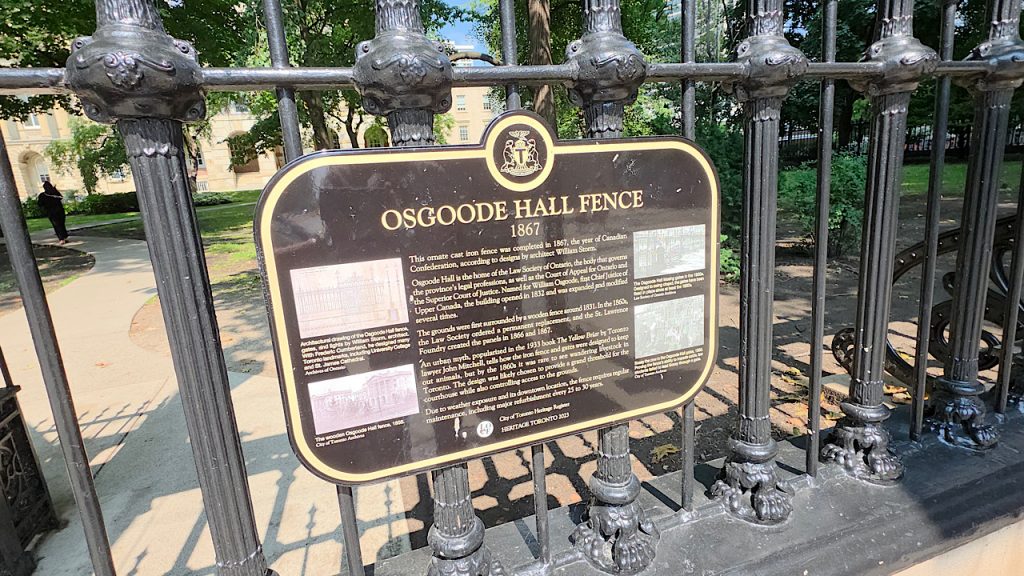
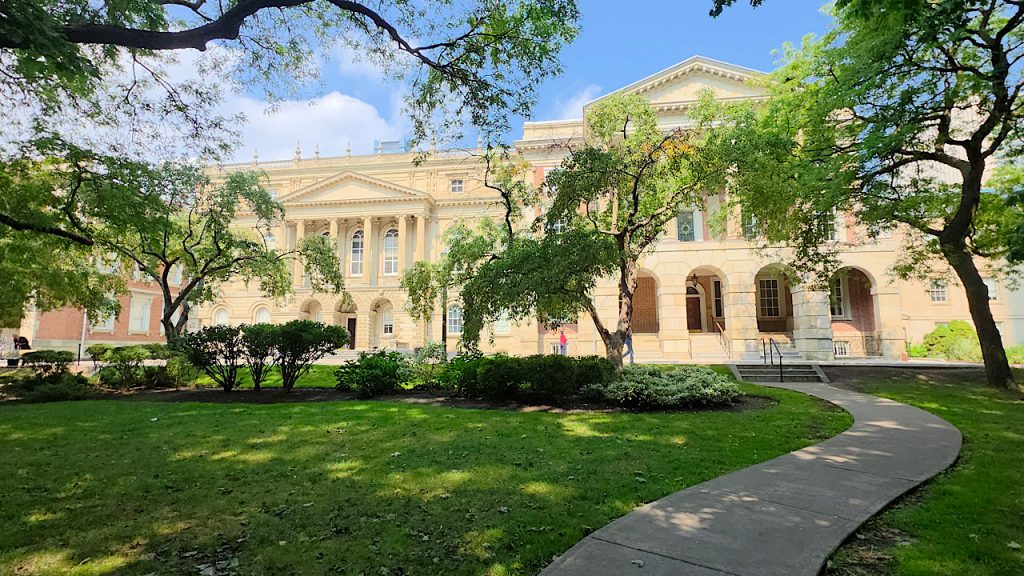
Quite literally, just around the corner you will come to what is thought to be the star attraction of Downtown Toronto. That may be true for the many tourists we saw milling around the Square, although for us, we saw plenty of other, less touristy sights. However, sometimes these places must be added the list for completeness.
Nathan Phillips Square is named after the mayor of Toronto who was in place from 1955 to 1962 and who was classed as visionary for the Square’s evolution. There are a number of things to note when ticking off the Square. You have the required selfie at the Toronto sign in front of the fountains and admire the new City Hall building. And of course you cannot bypass the Old City Hall, which, for us spoke much more eloquently to us, with its history, ghosts and more traditional storybook.
We can admire modern architecture although it is appreciating the old that matters most to us and the story it tells of how we have landed here, at this place, today. It is certainly a magnificent building, its architecture that of a Romanesque style, with different coloured brick giving it an unusual facade. The Clock Tower, which was once the tallest building in the city, is one of its biggest draws. Also at the time of the City Hall’s construction it was the largest civic building in Northern America. It was home to government offices and was the courthouse up until 1953. Since 1984 it has been on Toronto’s National Heritage Site list. At the time of writing, the Hall is currently vacant and there are discussions about how the building will be repurposed for the future.
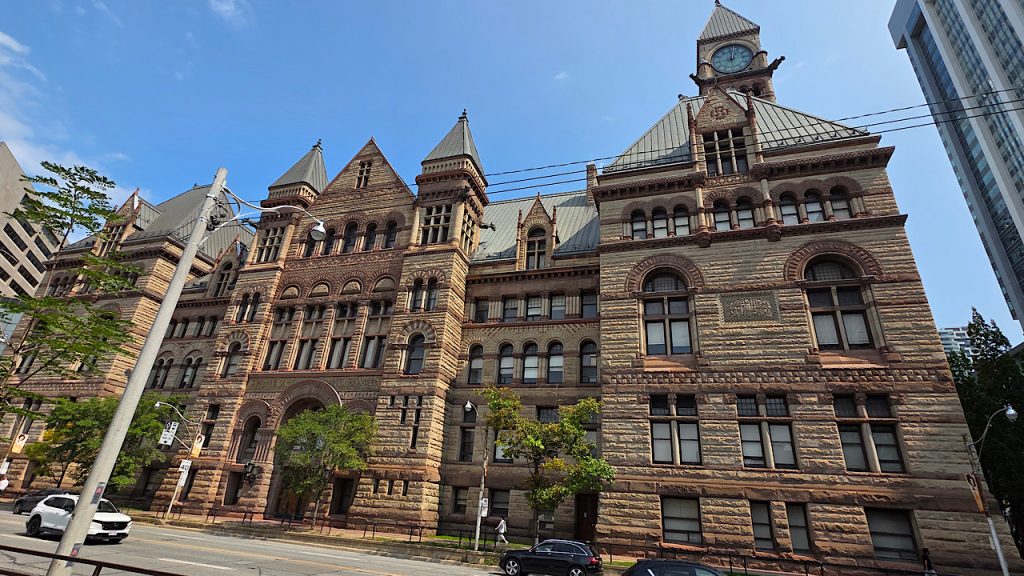
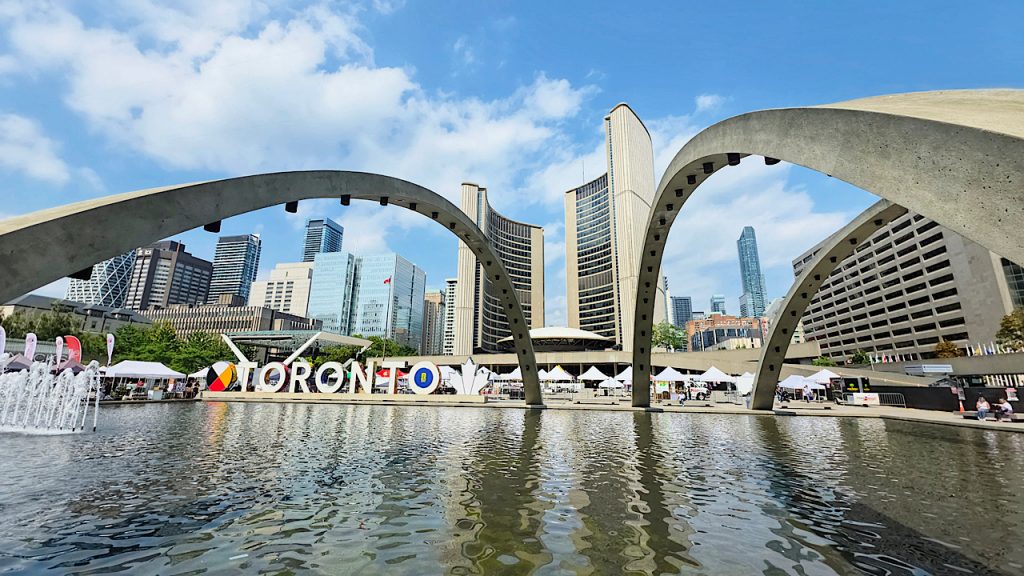
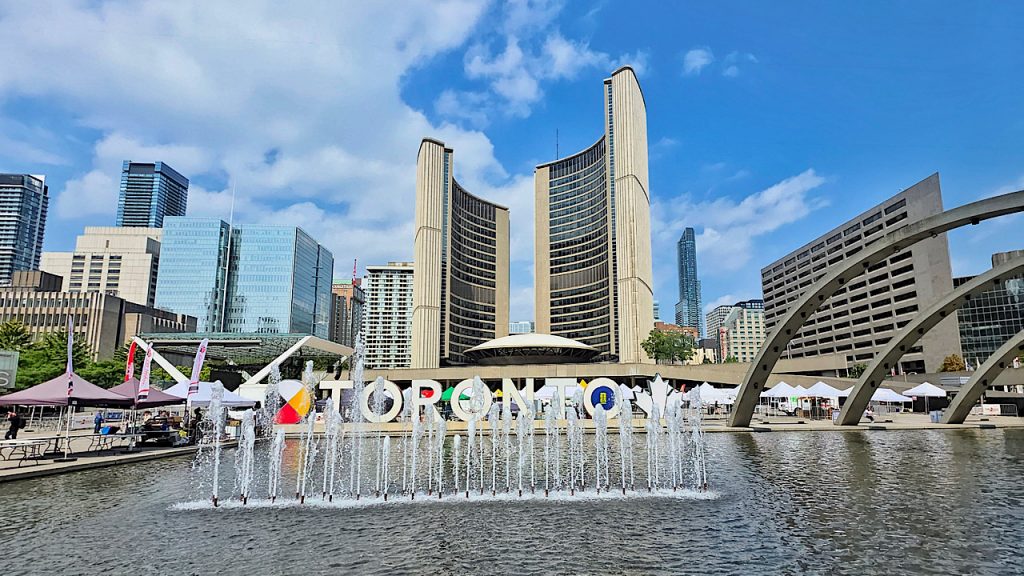
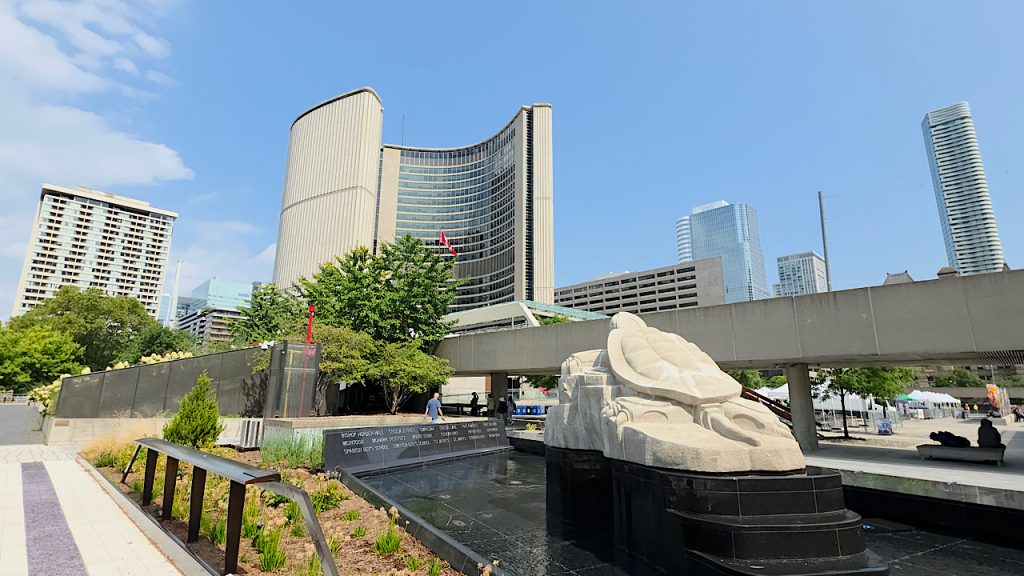
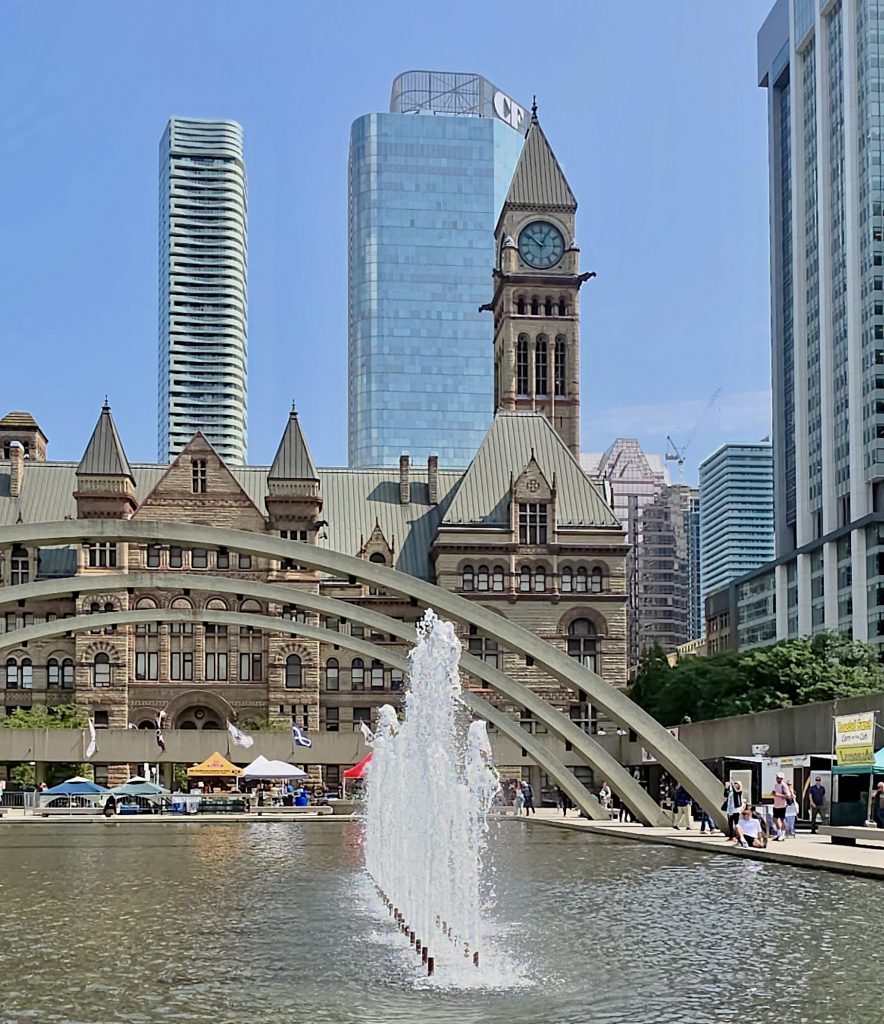
And that brings you to the end of your day’s excursions. Of course in there might be a lazy lunch as you watch the world go by, with sufficient space to allow for engaging with the museums and civic buildings should this be your thing. Perhaps the day can be rounded off with a drink at the Harbourfront as you allow your feet to calm down from all its activities. All this in preparation for the evening events, which is the cherry on the top, the icing on the cake and possibly your number 1 Toronto highlight.
4. Evening highlight – Toronto by night
You might notice, by its absence that we have not yet mentioned Toronto’s most famous and perhaps most iconic attraction which is high on everyone’s list. The CN Tower. As Canada’s national symbol, this tower was built in February 1973 and is the tallest observation tower in the western hemisphere. It was built, as was much of Toronto, on reclaimed land from Lake Ontario, thanks to a treaty with First Nation indigenous people who called this place home. The land here was an integral part of their cultural heritage and meeting place. The Tower opened for the first time in June 1976.
From the top, on a clear day, you are able to see at least 100 miles across to Niagara on the Lake. And the daytime spectacle is certainly worthy of your entry ticket that starts from $45 per person. We would suggest as much advanced booking as possible, as the tower has many visitors;, 2 million over the course of the year. So make sure you book well ahead if you can, so that you get the time schedule you want.
Having said that, we booked on the day and managed to get a time slot that gave us the best of both worlds, day and night. For us, in September, a 6.30pm entry allowed for a daylight viewing and also a nighttime spectacle as the sun went down. It was quite incredible. So if you can do the two, then the wonders of the cityscape changing its personality with the sky’s changing colours is quite magical.
Once you enter the tower, you have to queue up for the 58 second lift that carries you at 22kmph to the first Observation level at 346m. However a word of caution, part of the queue is to get you to pose for a photo that will cost you $50 that’s around £25! We bypassed this with the speed of a hunted gazelle. We wanted to get to the heart of the experience and that is to witness the views and see the world from a bird’s eye. Stepping out from the lift you have a couple of viewing options. You can just stand amongst the crowds and walk around the 360° Observation.
The other option is to go to the next floor where you can find a bit more privacy. There is a viewing platform that you climb onto with rails and just feel a sense of freedom. Even with his acrophobia Myles was able to get onto these individual platforms.
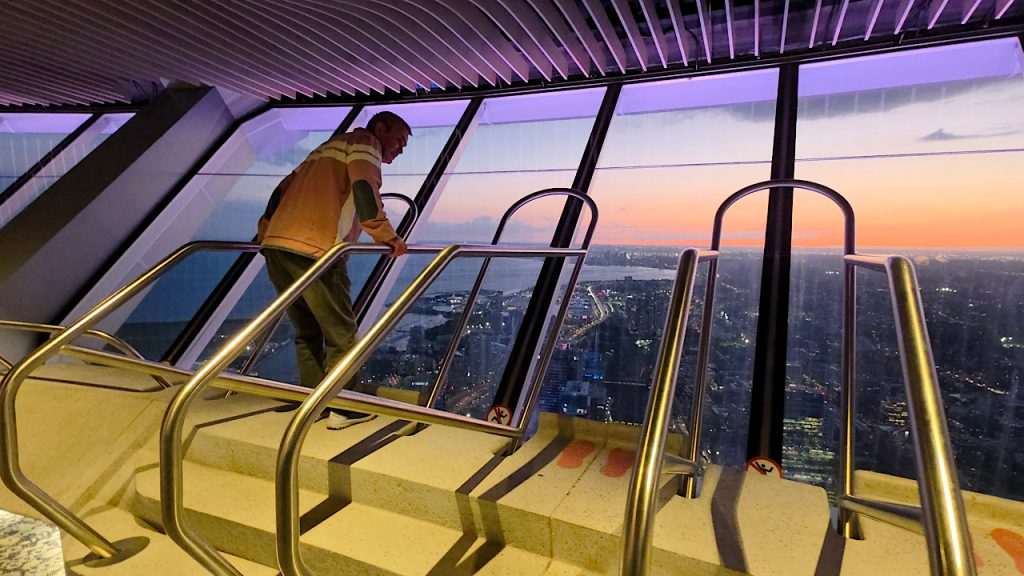
There’s also a perspex floor from where you can see all the way to the ground. Personally I found it a bit lame having been on the Blackpool Tower floor, which is epic in comparison. Of course if you are an adrenalin junkie, then there are parts of the tower where you can have a more extreme experience by braving the Edgewalk around the outside of the Observation tower. For $199 per person, so that’s about £105 per person. Or perhaps you just fancy the comfort of seeing the world around you by making a reservation at the 360 restaurant. As long as you spend over $75pp, you don’t need to buy an entry ticket to the main Observation tower. So it can be quite a good deal to eat there. However, you must book a long way in advance to get a table.
So the CN Tower is well worth a trip and the investment, especially if you time your visit at the back end of daylight hours so that you can benefit from stunning daytime views and get the magic from the city’s lights as the sun dips and the night arrives. It is a very special experience and excellent value for money.
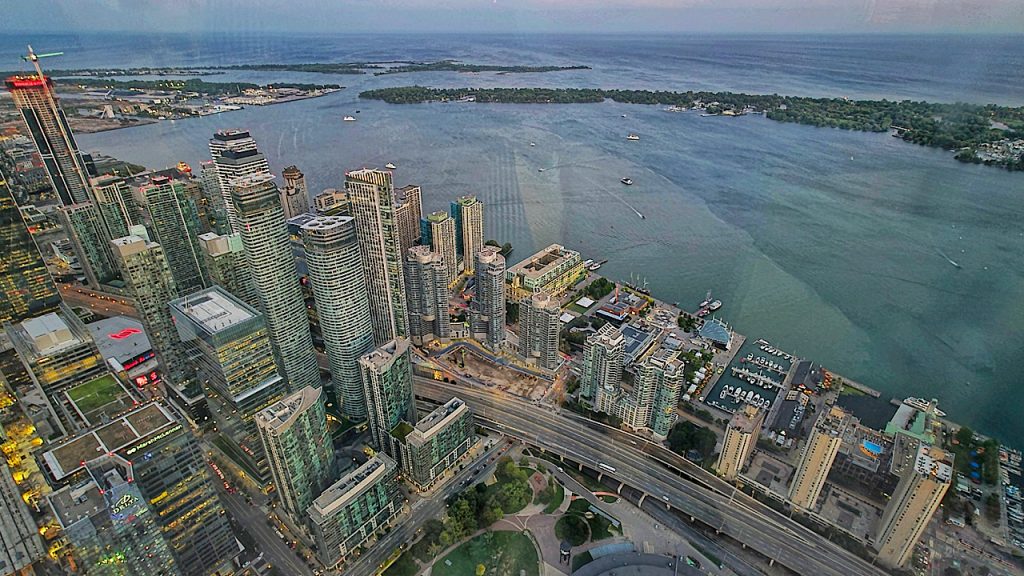
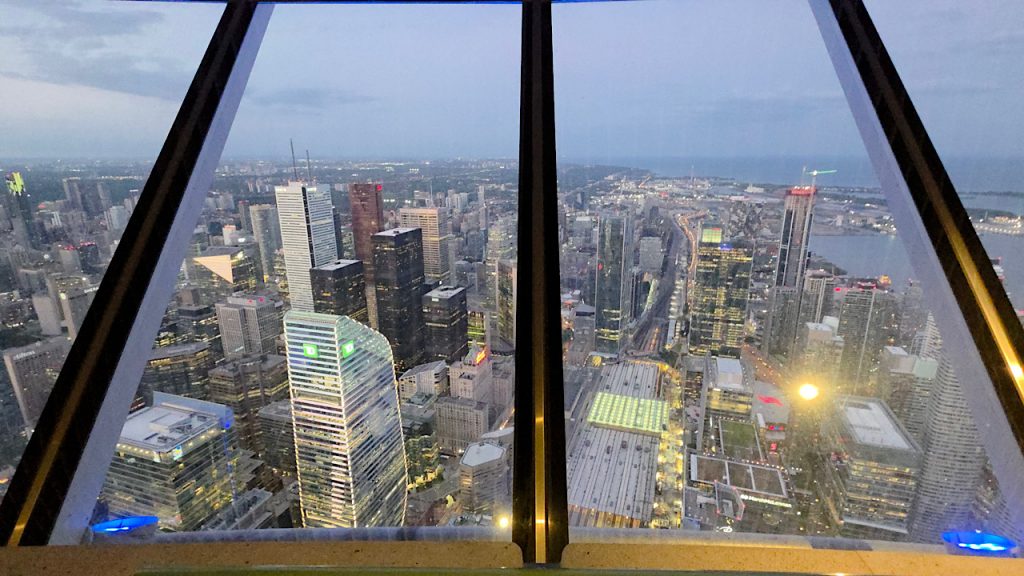
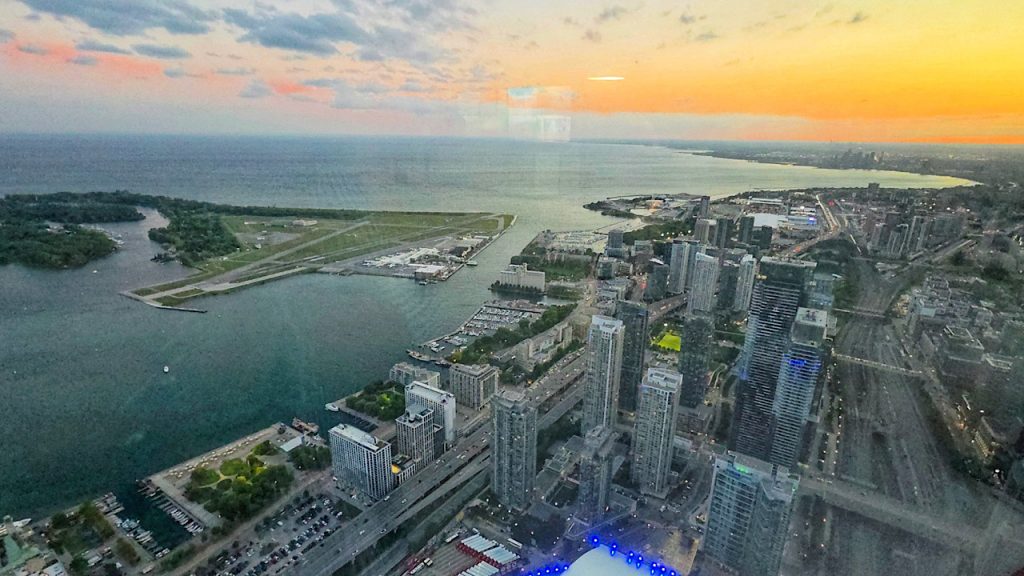
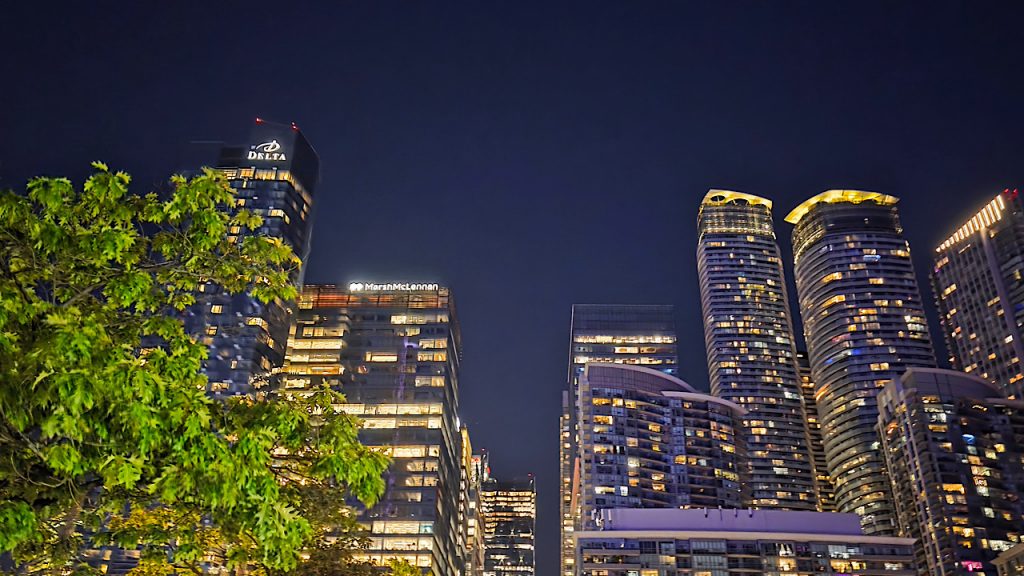
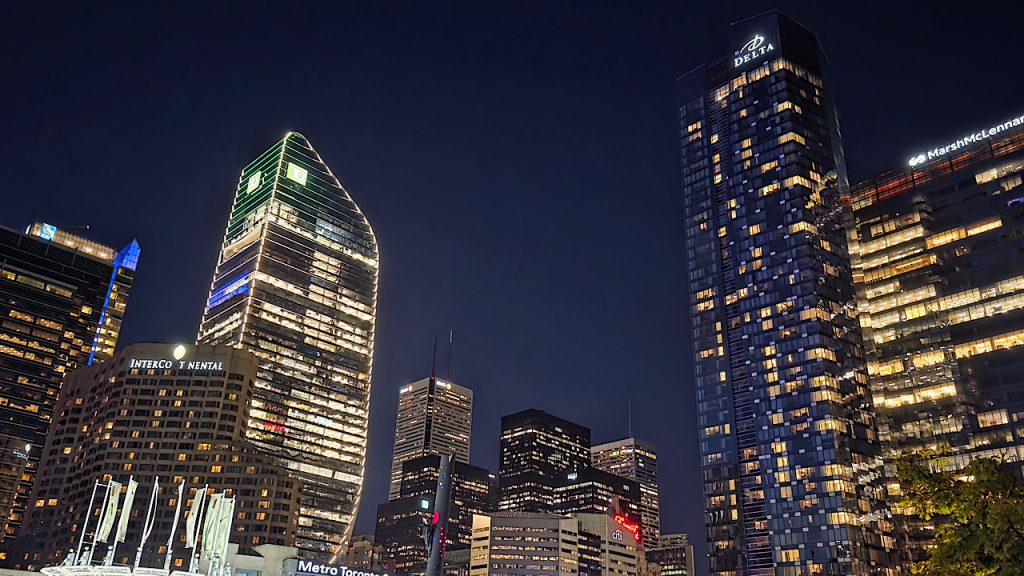

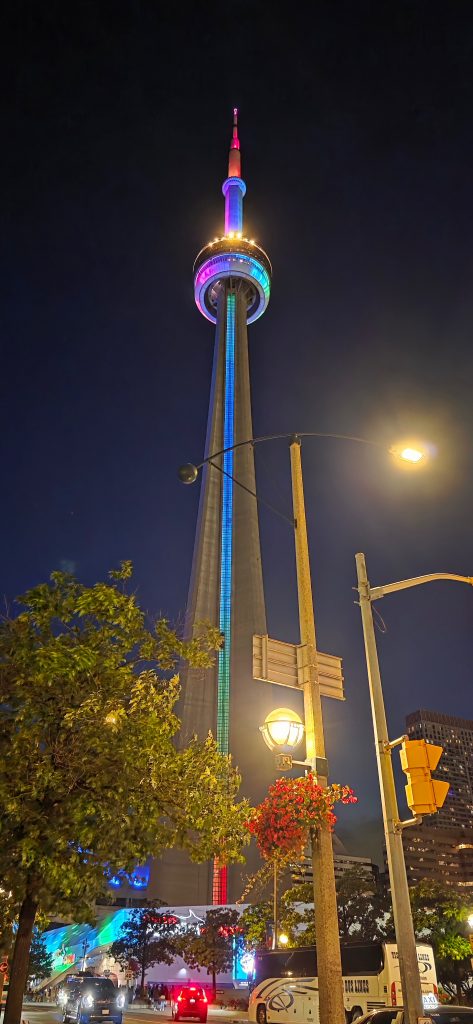
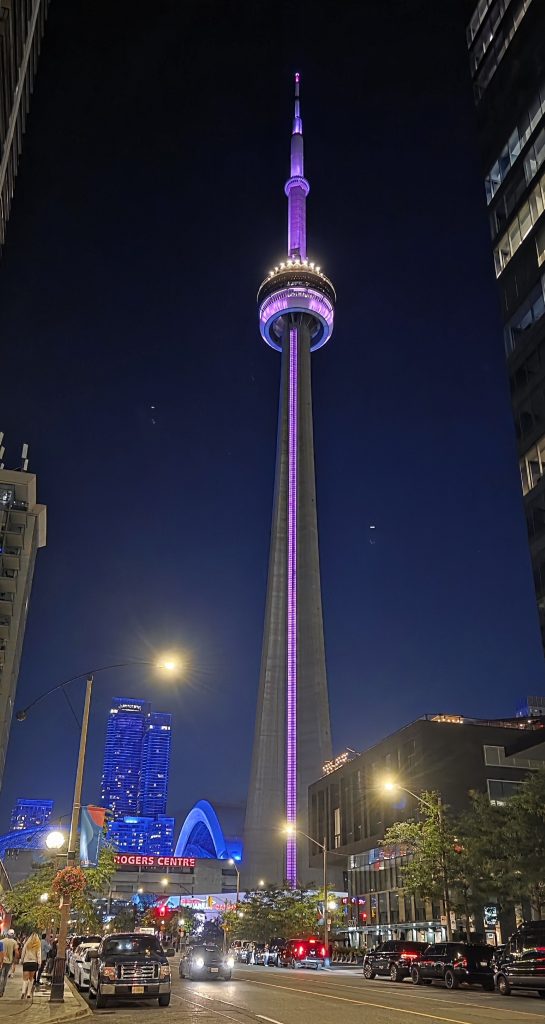
5. Wrapping up
Toronto was a lovely surprise for us, giving we are not city lovers. We found it to be quiet, mesmerising yet vast. So being able to cherry pick the best bits, allows you to get a really good flavour of this urban landscape. Despite its gigantic skyscrapers, there is something strangely alluring about them, as you get a sense of your insignificance in the world as you become tiny dots amongst these towering giants.
With the greenery of the islands, the perspective from the water, the views from up above and walking along the streets feeling the ground level vibe, Toronto is a great experience for a couple of days. All angles are covered and you get a holistic perspective of this Ontario capital.
We hope that this guide has been useful in giving you an account of the top spots that this city offers the explorative tourist. For more information on our Canada trip and other areas of the world we have covered, head to our website at www.motoroaming.com.

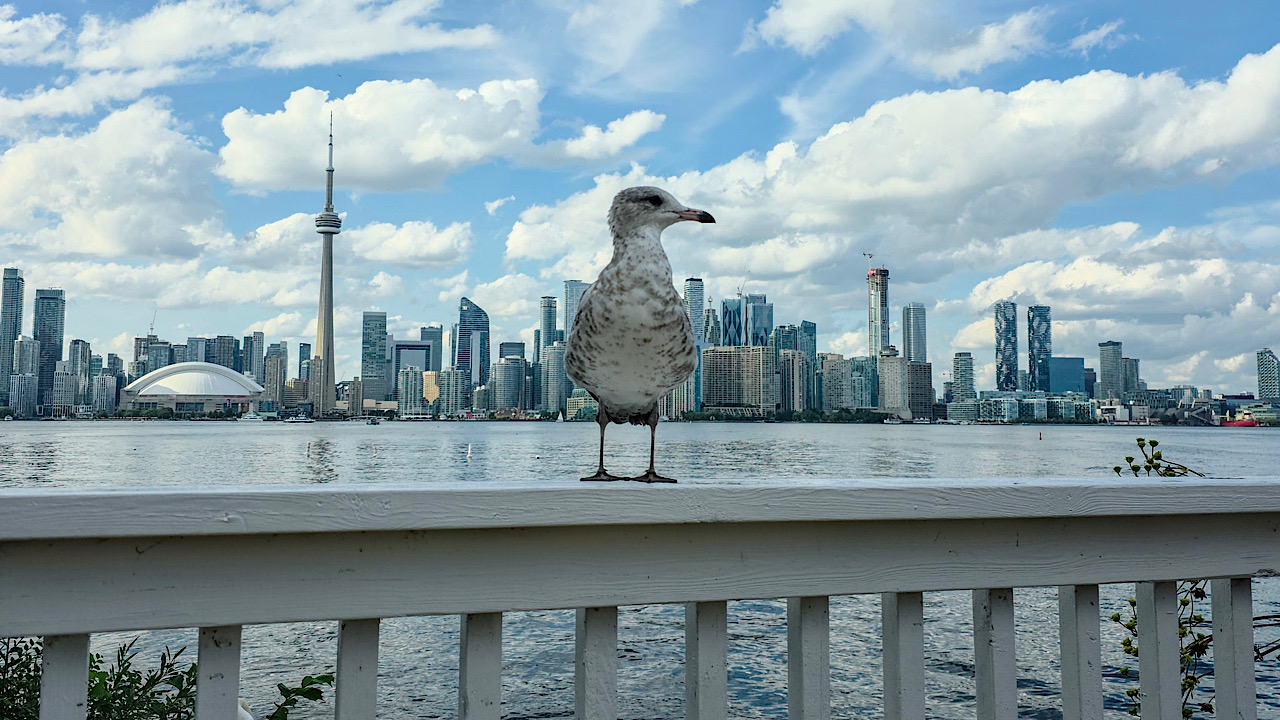
0 Comments